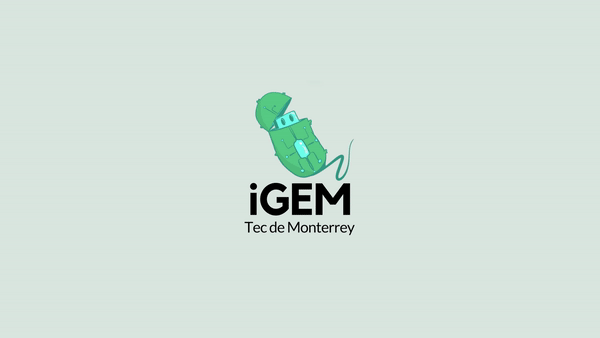EstebanDLPT (Talk | contribs) m |
|||
| Line 145: | Line 145: | ||
<div class="body-title">Procedure</div> | <div class="body-title">Procedure</div> | ||
<div class="texto-izquierda"> | <div class="texto-izquierda"> | ||
| − | + | In order to achieve Bronze requirement #4, the Interlab procedure was successfully carried out, following the iGEM 2018 Interlab Study Protocol. To obtain calibration and experimental data, the following material were used: competent cells from <i>E. coli</i>'s strain DH5a, 96 well plates (black with a clear flat bottom), and the measurement kit, which contains Ludox, silica beads and fluorescein. The first part of the protocol involved generating standard curves for OD measurements, cells and fluorescein. Using a Ludox solution, it was possible to obtain the following reference point for an OD<sub>600</sub>. | |
| − | The | + | The conversion value obtained was then used to convert any measurement of cell density into OD<sub>600</sub> by multiplying by 2.897, using the same instrument under the same conditions. |
</div> | </div> | ||
<div class="imagen-derecha"> | <div class="imagen-derecha"> | ||
| Line 156: | Line 156: | ||
</div> | </div> | ||
<div class="contenido"> | <div class="contenido"> | ||
| − | The particle standard curve was | + | The particle standard curve was obtained using silica microspheres, which have the same size and optical characteristics of bacteria cells. The standard curve was then used to convert ABS<sub>600</sub> to an estimated number of cells. The following standard curve was obtained: |
</div> | </div> | ||
<div class="imagen-centrada-reducida"> | <div class="imagen-centrada-reducida"> | ||
<img src="https://static.igem.org/mediawiki/2016/7/7f/T--Tec-Monterrey--PM10.png"> | <img src="https://static.igem.org/mediawiki/2016/7/7f/T--Tec-Monterrey--PM10.png"> | ||
| − | <div class="leyenda">Figure 1: Normal Table with values</div> | + | <div class="leyenda">Figure 1: Normal Dsitribution Table with values</div> |
</div> | </div> | ||
<div class="contenido"> | <div class="contenido"> | ||
| − | Finally, a fluorescein standard curve was made to calculate the fluorescence values of | + | Finally, a fluorescein standard curve was made to calculate the fluorescence values of transformed bacteria with GFP. The filter used for the measurements was used according to the recommended values (Bandpass: 530 nm/ 30 nm, width: 25-30 nm, exicitation 485 nm and emission 520-530 nm). The following curves were obtained: |
</div> | </div> | ||
<div class="imagen-centrada-reducida"> | <div class="imagen-centrada-reducida"> | ||
| Line 170: | Line 170: | ||
</div> | </div> | ||
<div class="contenido"> | <div class="contenido"> | ||
| − | Using the previous standard curves it | + | Using the previous standard curves, it became possible to continue with the cell measurement protocols with transformed <i>E. coli</i> DH5a strains. The following devices from the IGEM kit were transformed: |
</div> | </div> | ||
<div class="imagen-centrada-reducida"> | <div class="imagen-centrada-reducida"> | ||
<img src="https://static.igem.org/mediawiki/2016/7/7f/T--Tec-Monterrey--PM10.png"> | <img src="https://static.igem.org/mediawiki/2016/7/7f/T--Tec-Monterrey--PM10.png"> | ||
| − | <div class="leyenda">Figure 1: Normal Table with values</div> | + | <div class="leyenda">Figure 1: Normal Distribution Table with values</div> |
</div> | </div> | ||
</section> | </section> | ||
| Line 183: | Line 183: | ||
<div class="contenido"> | <div class="contenido"> | ||
<div class="body-subtitle">Absorbance</div> | <div class="body-subtitle">Absorbance</div> | ||
| − | Absorbance of cells at t= | + | Absorbance of cells at t=0 h and t=6 h are shown in the following diagram. |
</div> | </div> | ||
<div class="imagen-centrada-completa"> | <div class="imagen-centrada-completa"> | ||
Revision as of 19:38, 28 September 2018





Interlab
Fifth International InterLab Measurement Study
Procedure
In order to achieve Bronze requirement #4, the Interlab procedure was successfully carried out, following the iGEM 2018 Interlab Study Protocol. To obtain calibration and experimental data, the following material were used: competent cells from E. coli's strain DH5a, 96 well plates (black with a clear flat bottom), and the measurement kit, which contains Ludox, silica beads and fluorescein. The first part of the protocol involved generating standard curves for OD measurements, cells and fluorescein. Using a Ludox solution, it was possible to obtain the following reference point for an OD600.
The conversion value obtained was then used to convert any measurement of cell density into OD600 by multiplying by 2.897, using the same instrument under the same conditions.

Figure 1: Table for the conversion value of OD600.
The particle standard curve was obtained using silica microspheres, which have the same size and optical characteristics of bacteria cells. The standard curve was then used to convert ABS600 to an estimated number of cells. The following standard curve was obtained:

Figure 1: Normal Dsitribution Table with values
Finally, a fluorescein standard curve was made to calculate the fluorescence values of transformed bacteria with GFP. The filter used for the measurements was used according to the recommended values (Bandpass: 530 nm/ 30 nm, width: 25-30 nm, exicitation 485 nm and emission 520-530 nm). The following curves were obtained:

Figure 1: Normal Table with values
Using the previous standard curves, it became possible to continue with the cell measurement protocols with transformed E. coli DH5a strains. The following devices from the IGEM kit were transformed:

Figure 1: Normal Distribution Table with values
Results
Absorbance
Absorbance of cells at t=0 h and t=6 h are shown in the following diagram.

Figure 1: Normal Table with values
It can be seen that for all transform bacteria growth after 6 hours. Some of the devices, such as device 1 and 5 didn´t growth sufficiently as other transform bacteria.
Absorbance
Fluorescences values at t=0h and t=6 h

Figure 1: Normal Table with values
Conclusion
Fluorescence values obtained by GFP show that some devices emit greater fluorescence values than others.The negative device show no/ little fluorescence at both time. Device 3 didn’t show any fluorescence at all which affect the measurements of it. The device that show the greater fluorescence value was device 4.


